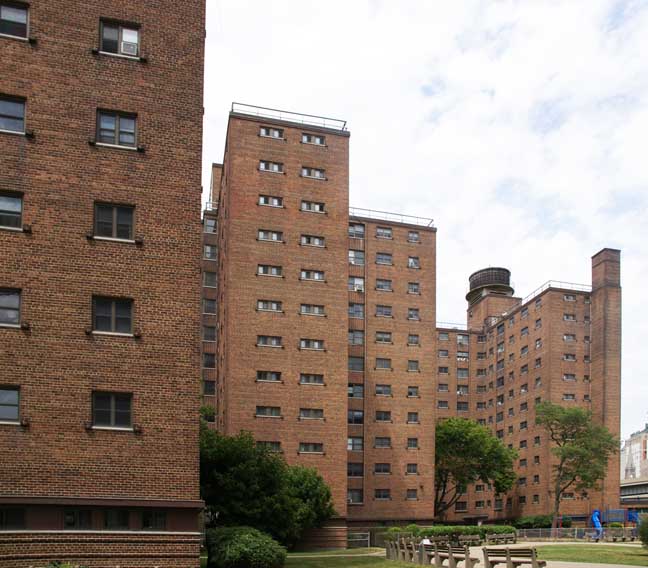Marine Drive Apartments
205 Marine Drive, Buffalo, NY
![]()
Marine Drive Apartments
205 Marine Drive, Buffalo, NY
|
Excerpts from
My Favorite Buildings: Marine Drive Apartments By Steel Published on Buffalo Rising on June 23, 2014 Reprinted with Permission  The complex of seven 12 story brick towers was originally called Dante Place, for the street that runs through the area. That was also the name of the former neighborhood at this site. Dante place had a long history as one of Buffalo’s oldest and most notorious neighborhoods. By the late 1940s, city leaders determined that the area needed to be cleaned up (read that as “eliminated”). The solution was to replace it with a modern housing complex based on the urban planning ideas developed by the famous modernist Swiss architect Le Corbusier. The plan included removal of the old neighborhood for construction of the 7 cross-shaped towers surrounded by park like grounds. These plans were hatched at a time when Buffalo was filled to the brim with people and crumbling dark old buildings. The vision of simple modern buildings is green space was extraordinary to their mid-century eyes. At mid-century, modernity was going to solve all problems. Just get rid of the dark and dirty old city and “poof” problem fixed. That never really worked out however. Now to the eyes of many in 2014, these buildings have become the dark old grimy structures of the past. But these buildings have fared far better than most public housing projects. The 616 apartment unit complex was completed in 1952. About 100 families were removed to build the buildings. Surrounded by water and industry, the project had no other residential neighborhood adjoining its site. Because of this there was no opposition to the giant project filled with low-income residents and especially low-income African-American residents. Early on, Marine Drive was actually one of the most racially mixed public housing projects to be found anywhere. In 1954 its resident mix included 36% African-Americans. That number would be unusual even today, let alone back in the 1950s. By 1959, however, African-Americans made up most the residents at 68%. By 1960 the complex had already become a source of controversy, as reports of bad management, lack of maintenance, crime, and poor living conditions, filled the papers. Political leaders began to rethink the wisdom of having a poor, mostly Black population near downtown on the waterfront. Early thoughts of rejuvenating the waterfront were being discussed and Marine Drive was seen as a major impediment to development. Plans were hatched to turn the buildings into middle-income housing. These plans stirred up more controversy and muddled along in the courts for several years. I could not find out what eventually transpired but I did see something written about formation of a tenant’s management council. At some point the buildings were stabilized and became a desirable place to live with none of the usual problems of public housing projects. Today, I believe, a majority of the apartments are subsidized rentals for seniors. So, why do I like them; these buildings, rendered in an iconic architecture associated with poverty and failure? Certainly, the complex is not a masterpiece of art. I understand they can be hard to love . But take time to appreciate them and their merits become clear. I think you have to get up close to the towers and walk around the property to get an appreciation for them. The surrounding grounds are quite pleasant with mature trees and some nice public gathering spaces. It is the opposite of the bland windswept no-mans-land that typically surrounds public housing. Up close the buildings have a bold presence. The simple blocky shapes create dramatic spaces as you pass between their wings. They are very plain in design but closer inspection reveals some nice details. The brown brick has a rich texture accented with a few subtle details. I love the little protruding blocks of brick jutting out at the end of each window sill. The buildings have an interesting recessed strip at the first floor that creates a deep shadow giving the heavy masses a light feeling at ground level. The tops are treated with a continuous guard rail that forms a kind of cornice. These are not master pieces but they are pleasant. It has become a highly desirable neighborhood and adds to the Buffalo’s downtown population. |
web site consulting by ingenious, inc.